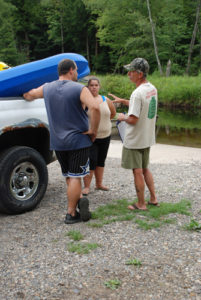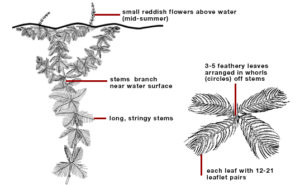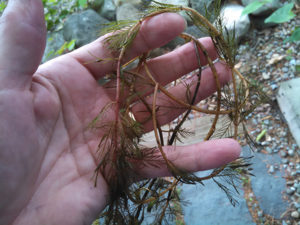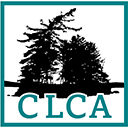
An increasing number of Adirondack Lakes are infested with aquatic invasive species that damage lake ecosystems, threaten recreational uses of these waters, and reduce property values.
Click here for a 2015 map of the Adirondack Lakes monitored for Aquatic Invasive Species.
We at the Canada Lakes are fortunate not to have these pests, and the Invasive Species Committee continues its work to keep our waters safe, in partnership with the Town of Caroga and NY DEC. In the 2014 season, two paid and eighteen volunteer Lake Stewards inspected over 600 boats at the West Lake boat launch. Of these boats, some 15% had been in infested waters in the previous two weeks. The volunteer Lake Inspectors surveyed the shorelines in August and found no evidence of invasives. While most boaters understand the risk of spreading invasive species, the stewards continue to find and remove vegetation from boats and trailers, so more public education is needed. The new law and regulations requiring boats to be cleaned before launching in state waters should help, but we still need to keep up our preventive work at the West Lake site. The cost of these programs is shared between the Association and the Town, with the Town putting the two paid stewards on the town payroll, for which we are very appreciative.
If you would like to help with this important work, we are always looking for more volunteers to serve as Lake Stewards and Lake Inspectors. Volunteer Stewards generally work 3-4 hour shifts at the boat launch one weekend in July and one in August. If you want to serve as a Steward, contact Mike Durkee (DURKEEML@hotmail.com; 202-247-5895). If you want to be an Inspector (surveying a designated shoreline in August), please contact Marcus Harazin (marcusharazin@gmail.com; 518-439-6387). New Lake Stewards attend a half-day training program, usually in late June at the Adirondack Museum at Blue Mountain Lake. New Inspectors are taken on a field trip to Caroga Lake to observe the Eurasian Water Milfoil growing there. If you see anything that looks like an invasive plant in the water, please contact either Marcus or Mike.
While the Lake Stewards and Inspectors are doing their best to prevent the spread of invasive species to our lakes, it is hoped that all residents monitor their own shore line. The attached Quick Field Guide is intended to distinguish native and invasive aquatic plants


While we fortunately to date have not found any Eurasian Water Milfoil in Canada Lake, the experiences of Paradox Lake are instructive. See the Paradox Lake Website.
We are also beginning a program to eradicate terrestrial invasive plants in our area.
Links to Important Resources and Studies:
Department of Environmental Conservation, New York State Aquatic Invasive Species Management Plan, July, 2015: click here.
Governor Cuomo Announces Agreement to Prevent Spread of Aquatic Invasive Species in the Adirondacks: click here.
Darrin Fresh Water Institute, Aquatic Vegetation of Canada Lake, West Lake, and Green Lake, Town of Caroga, New York, prepared by Lawrence Eichler and Charles Boylen, 2013: click here
Adirondack Park Invasive Plant Program (APIPP) website: click here
Report: The Actual and Potential Economic Impact of Invasive Species on the Adirondack Park: A Preliminary Assessment, prepared by Yellow Wood Associates, Inc., 2014: Click here
Preventing the Introduction and Spread of Invasive Species: Click here.
Report: Boat Inspection and Decontamination for Aquatic Invasive Species Prevention, prepared by Paul Smith’s College, March, 2014: Click here
DEC Pamphlet, Anglers and Boaters: Stop the Spread of Aquatic Invasive Species and Fish Diseases in New York State, Click here.
New York State Department of Environmental Conservation: Aquatic Invasive Species in New York State: http://www.dec.ny.gov/animals/50121.html
Maine Volunteer Lake Monitoring Program, Click here.
Vermont’s Watershed Management Division: Aquatic Nuisance Species Links: Click here.
Zebra Muscles http://fl.biology.usgs.gov/Nonindigenous_Species/Zebra_mussel_FAQs/zebra_mussel_faqs.html
Rock Snot http://nyis.info/plants/RockSno t.aspx
